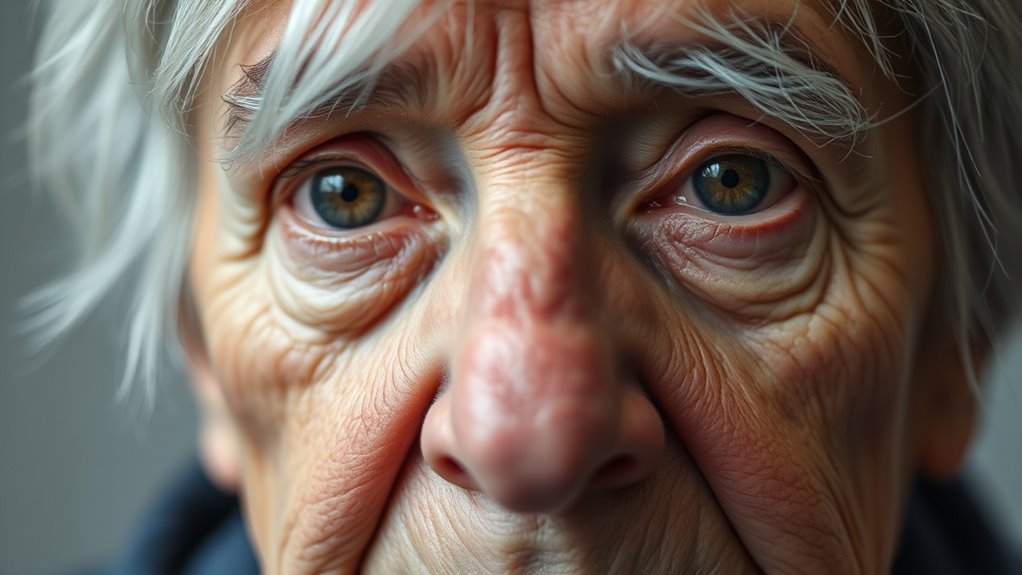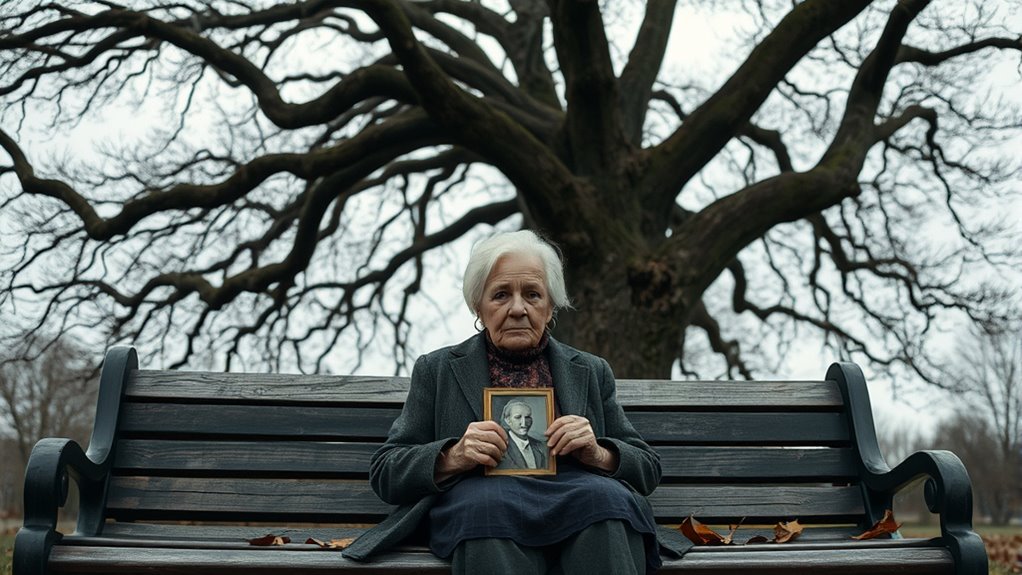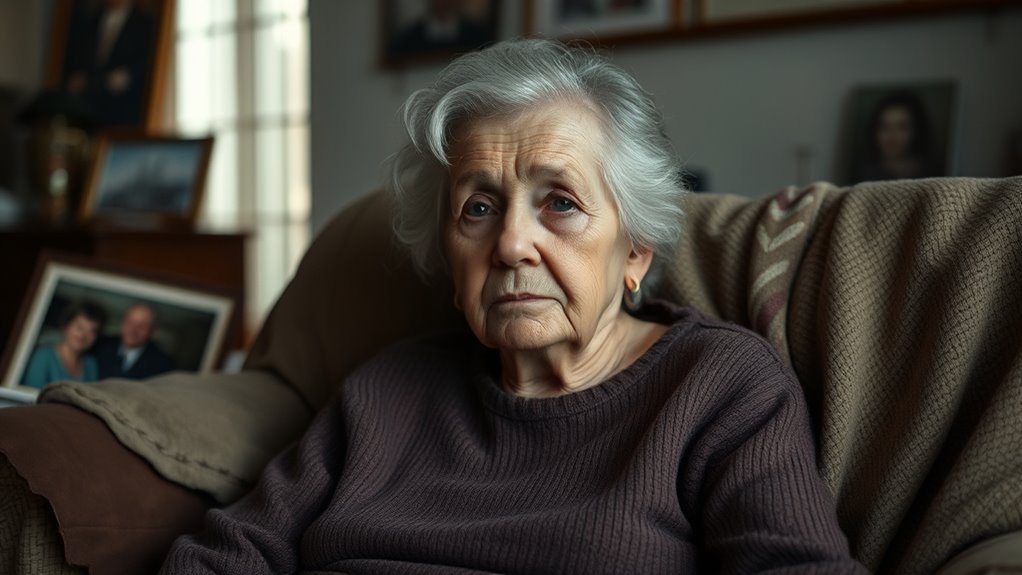Borderline Personality Disorder can develop later in life, often triggered by stressors like relationship issues, health challenges, or past trauma, especially childhood abuse or neglect. Older adults may show different symptoms, making diagnosis tricky. Recognizing late-onset BPD helps you get proper support and tailored treatments. Understanding how trauma and life changes influence BPD in aging people gives you better insight into managing symptoms effectively as you explore further.
Key Takeaways
- Late-onset BPD appears around age 30 or later, often triggered by life stressors and past trauma such as childhood abuse.
- Symptoms include emotional dysregulation and interpersonal instability, with impulsivity and suicidality decreasing with age.
- Accurate diagnosis is challenging due to age-related symptom expression and limitations of traditional assessment tools.
- Tailored, trauma-informed treatments like adapted DBT and psychoeducation improve management in older adults.
- Recognizing BPD in later life enhances personalized care, addressing trauma, stressors, and improving quality of life.
Understanding Late-Onset BPD: Key Features and Differences

Understanding late-onset BPD requires recognizing how it differs from early-onset cases. Late-onset BPD often appears around age 30 or later, usually triggered by life stressors like loss or trauma rather than developmental issues.
You might notice ongoing emotional dysregulation and interpersonal instability, but symptoms such as impulsivity and suicidality tend to lessen with age.
Trauma history, especially childhood sexual abuse or emotional neglect, often underpins late-life presentations.
Diagnosis in older adults can be challenging because traditional clinical assessment tools may not effectively detect symptoms, and age-related features influence symptom expression.
Developmental differences mean that symptom progression may follow a different trajectory, emphasizing the importance of understanding the unique clinical profile of late-onset BPD in evaluating and managing older adults.
Additionally, incorporating somatic therapy approaches can be beneficial, as they address the emotional regulation challenges associated with BPD by integrating mind and body for emotional healing. The use of body awareness techniques can be particularly helpful in this process.
Recognizing the developmental variations in symptom manifestation can further enhance tailored treatment strategies for this population.
A comprehensive understanding of neurobiological factors involved in late-onset BPD can also inform more effective interventions, especially considering age-related brain changes. Moreover, understanding neuroplasticity can help guide therapeutic approaches in older adults, promoting recovery and resilience.
Factors Contributing to BPD Manifestation in Older Adults

You might notice that life stressors, like relationship conflicts or health issues, often trigger BPD symptoms in older adults. Past trauma, especially childhood abuse or neglect, can also resurface and act as a catalyst for recent difficulties. Recognizing these factors helps in understanding how BPD can develop or worsen later in life. Additionally, vetted portable camping gear can provide a sense of stability and control for some individuals coping with emotional challenges. Understanding the emotional and physical effects of narcissistic abuse can also shed light on how these experiences influence mental health in later years. The impact of ongoing emotional manipulation can exacerbate feelings of confusion and helplessness, underscoring the importance of support systems in recovery. Proper location and installation considerations, such as creating a safe environment and avoiding hazards, emphasize the importance of a secure setting that can reduce environmental stressors and promote well-being.
Life Stressors Triggering Symptoms
As individuals age, life stressors such as relationship losses, employment challenges, and major life shifts can markedly trigger or worsen symptoms of borderline personality disorder (BPD).
For older adults, psychosocial stressors like social isolation and interpersonal conflicts often act as trauma triggers that intensify BPD symptoms.
Age-related shifts, including retirement or health declines, can heighten emotional reactivity and vulnerability.
Relationship losses and experiences of emotional abuse may also serve as acute stressors, leading to increased emotional instability.
These stressors often interact with pre-existing vulnerabilities, making symptoms more pronounced.
Recognizing how everyday life challenges and social changes impact BPD in later life is vital for understanding and managing the disorder’s manifestation among older adults.
Past Trauma as Catalyst
Past trauma, particularly childhood sexual assault, emotional neglect, and abuse, often plays an essential role in the development of BPD later in life. Many older adults with late-onset BPD have an early trauma history that remains unaddressed, fueling trauma-related symptoms.
Emotional neglect and attachment trauma can create deep-rooted vulnerabilities, which may resurface during psychosocial stressors or interpersonal conflicts. Reminders of past trauma, such as loss or betrayal, act as trauma triggers, intensifying BPD symptoms.
Even with stable, productive lives, unresolved childhood trauma can influence how older adults respond to current stressors. Recognizing the impact of early trauma helps explain why late-onset BPD manifests, highlighting the critical link between past trauma and emotional regulation difficulties in later years. The presence of electric bikes as alternative mobility options reflects a broader trend toward adaptive strategies that can support independence and well-being in aging populations. Additionally, understanding how AI vulnerabilities can impact mental health interventions underscores the importance of tailored, secure therapeutic approaches for trauma survivors. Being aware of trauma-related symptoms is crucial for clinicians to provide effective support and intervention strategies tailored to this demographic, especially considering how self-regulation can be challenged by unresolved trauma. Incorporating technology-based interventions that consider data privacy and ethical concerns can enhance treatment efficacy for this group.
Recognizing Symptoms and Diagnostic Challenges in the Elderly

Recognizing symptoms of Borderline Personality Disorder (BPD) in the elderly can be particularly challenging because standard diagnostic tools often fall short. Diagnostic challenges arise because elderly BPD may present with symptom variability and atypical features, complicating symptom assessment. Age-specific criteria are essential to distinguish BPD from age-related changes or other mental health issues common in older adults. Clinical diagnosis relies heavily on nuanced evaluation, but limited or outdated diagnostic tools hinder accurate identification. In geriatric psychiatry, understanding the unique, evolving symptom expression is *vital* for proper recognition, ensuring that diagnostic challenges don’t obscure the true nature of the disorder in older individuals. Additionally, the diagnostic criteria used for younger populations may not fully account for the presentation of BPD in later life, emphasizing the need for specialized assessment approaches.
Impact of Life Stressors and Trauma on BPD in Later Life

How do life stressors and trauma influence the manifestation of BPD in older adults? In later life, psychosocial stressors like interpersonal conflicts, relationship difficulties, and major life transitions—such as retirement or widowhood—can trigger or worsen BPD symptoms.
Trauma, especially attachment trauma from childhood, including emotional neglect or family conflicts, often underpins late-onset BPD episodes. These stressors have a significant psychological impact, intensifying emotional instability and interpersonal struggles.
Recognizing how life stressors and trauma contribute to late-onset BPD is essential for accurate diagnosis and effective intervention. Understanding these factors helps tailor treatment strategies, addressing the complex ways trauma and ongoing stressors influence BPD’s course in older adults.
Moreover, the use of glycolic acid products in skincare routines has been linked to improving skin texture and reducing signs of aging, which can be beneficial for older adults seeking to enhance their skin health amidst emotional challenges.
Approaches to Treatment and Support for Older Individuals With BPD

Effective treatment for older individuals with BPD requires adapting established approaches to address their unique emotional and interpersonal needs. You should consider therapy adaptation, such as modified Dialectical Behavior Therapy (DBT), to target emotional regulation and interpersonal difficulties. Incorporating trauma-informed care and life review helps process unresolved attachment issues, often linked to late-onset symptoms. Support strategies must include psychoeducation for both you and your caregivers, improving understanding of how BPD presents in later life. Enhancing social connectedness and reducing isolation are essential, given the impact of interpersonal difficulties. When designing treatment plans, clinicians must consider age-related factors like comorbidities and cognitive changes. Key approaches include:
- Therapy adaptation for emotional and interpersonal challenges
- Trauma-informed care and life review
- Psychoeducation and social support strategies
Additionally, integrating humorous dog quotes can serve as a therapeutic tool to foster positive interactions and alleviate stress in caregiving environments. Recognizing the importance of creativity in developing personalized interventions can inspire innovative ways to support older adults with BPD and promote resilience. Moreover, understanding the beauty hours of local service providers can assist in scheduling appointments and maximizing access to care. Incorporating the law of attraction principles may also help individuals focus on positive outcomes and foster emotional well-being, even amidst challenges. Exploring evidence-based practices ensures that interventions remain effective and tailored to this population’s needs.
Future Directions in Research and Clinical Practice for Late-Life BPD

Advancing our understanding of late-life BPD requires focused research efforts and adaptations in clinical practice. Developing age-specific diagnostic criteria and assessment tools is essential to accurately identify BPD in older adults, considering how the symptom course can differ across the lifespan.
Longitudinal studies will help clarify natural trajectories and fluctuations of symptoms, informing better management. Clinical training should emphasize recognizing late-onset BPD and distinguishing it from other geriatric mental health conditions.
Investigating trauma, attachment history, and life stressors will deepen insights into their roles in late-life BPD, guiding targeted, developmentally sensitive treatment approaches. Incorporating reviews of child development and understanding early life influences can further enhance treatment strategies. Integrating these strategies into geriatric mental health care promises to improve diagnosis, treatment efficacy, and quality of life for older individuals with BPD.
Frequently Asked Questions
What Happens to Borderlines as They Age?
As you age, some of your BPD symptoms, like impulsivity and suicidality, tend to lessen, making the disorder less noticeable.
However, core issues like fear of abandonment and manipulation often stick around. You might notice changes in how BPD presents itself due to brain development and life experiences.
Despite these shifts, ongoing emotional and relationship challenges may remain, requiring continued support and understanding as you navigate later life.
What Can Trigger BPD Later in Life?
Imagine you’re living through a twist of fate, like finding an old letter that stirs up painful memories. Stressors such as losing a job, ending a relationship, or experiencing major life changes can trigger BPD symptoms.
Reminders of past trauma, conflicts with loved ones, or reactivated childhood neglect often worsen symptoms. These triggers make it harder to manage emotions, especially when you’re maneuvering significant transitions like retirement or widowhood.
Does BPD Get Worse if Untreated?
If you leave BPD untreated, it generally doesn’t get worse quickly, but your symptoms can become more ingrained over time.
You might find it harder to manage emotional swings, impulsivity, and relationship issues.
Without intervention, these problems can intensify, making daily life more challenging and increasing the risk of co-occurring issues like depression or substance abuse.
Early treatment can help prevent these long-term difficulties and improve your quality of life.
Can a Person With BPD Be Normal?
Imagine you’re managing daily life, holding a steady job, and maintaining relationships—this is possible even with BPD. You might wonder if you can be “normal.”
The truth is, many people with BPD develop coping strategies that help them function well, despite persistent symptoms.
With treatment, support, and resilience, you can lead a fulfilling life, demonstrating that “normal” is more about adapting than being symptom-free.
Conclusion
Think of late-life BPD as a weathered ship steering stormy seas. As you age, the waves of stress and past storms can reshape your vessel’s course. Recognizing these signs helps you steer toward calmer waters, with the right support and treatment. Just as a skilled captain learns to read the skies, understanding late-onset BPD allows you to chart a new course for healing and stability, even amid life’s tempests.









